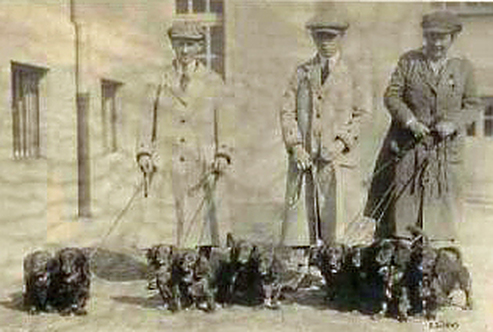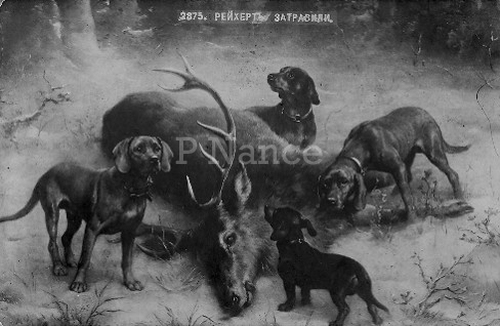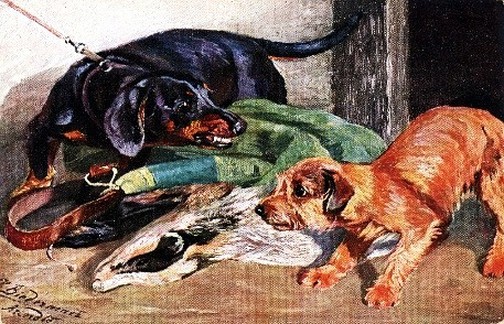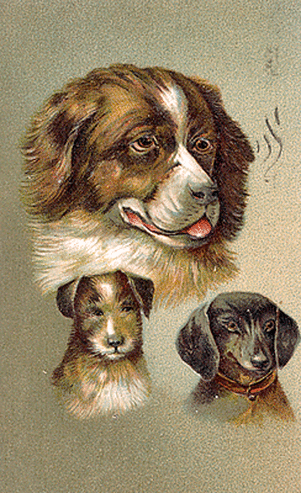Postcards
Many postcards in the "postcard era" of 1900-1920 were printed in Germany. So dachshunds are included in an astounding variety of antique postcards! The artwork and history depicted on the century-old cards are rich in depth and detail and wonderful to see. I am fortunate to have a very nice collection and will post one here each month.
June

An interesting use of color in this painting of a mother and her puppies. There is also noticeably less attention to detail than was common in those days but the artwork is very pleasing nonetheless.
Speaking of color, black and tan dachshunds were very highly regarded in Germany from early on, and especially by hunters.
May

Continuing the 'children at the piano' theme, here we have a different kind of dachshund helper!
April

Making beautiful music together! I can hear it now. haha!!
March

An intriguing photo-postcard of longhaired dachshunds from more than 100 years ago.
This may be the only card I post on these pages that I do not actually own. The image here was downloaded from an online website several years ago. My apologies for the poor quality of the scan.
It was suggested on that site that this photo was actually taken in France. Unfortunately, I do not know any details about it. I certainly wish that I did!
February

Three hunters and their two dogs take a little "lunch" break. Obviously, the big dog does not appear to be asking what's in the basket for him. The dachshund on the other hand...
This card was printed in Germany, probably in the 1920s. It has a divided back which was not used by the postal service and is clean of any markings. The artwork carries the artist's name H v Preen. I have seen this name on some other postcards with hunting, hunting dog, and beer drinking themes. I found that the artist was Hugo von Preen, an Austrian.
From Wikipedia: Hugo von Preen was born in 1854 in Osternberg son of an officer. His childhood was spent in Weinheim. From 1873 he studied at the Academy of Fine Arts in painting in Munich and from 1882 he lived in Osternberg as a freelance artist. In 1884 he co-founded the "Berger Art Colony", which existed until the turn of the century. In 1923 he established the "Innviertel Artists' Guild." Preen primarily painted landscapes, but also dealt with portraits, animals and hunting pictures. He preferred the small format and designed several series of postcards. Preen died in Austria in 1941.
This card was printed in Germany, probably in the 1920s. It has a divided back which was not used by the postal service and is clean of any markings. The artwork carries the artist's name H v Preen. I have seen this name on some other postcards with hunting, hunting dog, and beer drinking themes. I found that the artist was Hugo von Preen, an Austrian.
From Wikipedia: Hugo von Preen was born in 1854 in Osternberg son of an officer. His childhood was spent in Weinheim. From 1873 he studied at the Academy of Fine Arts in painting in Munich and from 1882 he lived in Osternberg as a freelance artist. In 1884 he co-founded the "Berger Art Colony", which existed until the turn of the century. In 1923 he established the "Innviertel Artists' Guild." Preen primarily painted landscapes, but also dealt with portraits, animals and hunting pictures. He preferred the small format and designed several series of postcards. Preen died in Austria in 1941.
January

Interesting photo, isn't it, two dachshunds posing beside a fox cub chained to a little house. (Or whatever the little wood structure is.) The dogs appear to be very good examples of the breed for that time - especially the dog on the right. Actually, the dog on the right may be a very good example of the breed for today.
The photo was taken, or at least published, in Vienna, Austria. The back is undivided which makes it quite an early postcard.
The card was postmarked in Amsterdam on July 13, 1904. It bears a "Nederland" 2.5 cent stamp.
It contains a message on the front and a simple address on the back. Unfortunately, I cannot read the writing. It has elements of German but I don't believe it is German. I suppose it is a good guess that the writing is Dutch!
It is also interesting to me that the dogs are wearing tags. I guess I wouldn't have thought that dog tags were made and used in 1904!
The photo was taken, or at least published, in Vienna, Austria. The back is undivided which makes it quite an early postcard.
The card was postmarked in Amsterdam on July 13, 1904. It bears a "Nederland" 2.5 cent stamp.
It contains a message on the front and a simple address on the back. Unfortunately, I cannot read the writing. It has elements of German but I don't believe it is German. I suppose it is a good guess that the writing is Dutch!
It is also interesting to me that the dogs are wearing tags. I guess I wouldn't have thought that dog tags were made and used in 1904!
December

November

October

September

"At the mid-day table."
August

A different take on the phrase "losing your lunch!"
July

Well, it is far from the noblest display of patriotism but there was across-the-board hatred for all things German here in 1919.
It is postally used, postmarked July 5, 2PM, 1919 in Bellville, Ohio, and has a one cent George Washington stamp. In very good condition, it is addressed in pencil to Mrs. C.D. Pifer, 327 E. 9th, Ashland, Ohio.
The message on the back is surprisingly benign considering the flip side of the card. "Dear Mother, We arrived all O.K. but I forgot to put paraffin on my jelly and it is in the kitchen cabinet will you do it for me. The girls wanted Grandma [ ]*, Blanche.
* I've tried hard but cannot make out Blanche's last word or words.
Dachshunds, a popular breed in the States prior to WWI, were commonly called "liberty dogs" when the war began, just as German Shepherds became "Alsations." I've read that the American Kennel Club officially changed the name Dachshund to Badger Dog for a short time but I have not verified this.
There's much to be found on the internet about the anti-German sentiment of that era. I have an estimated half-dozen postcards of similar theme which I'll post from time to time - but not too often!
It is postally used, postmarked July 5, 2PM, 1919 in Bellville, Ohio, and has a one cent George Washington stamp. In very good condition, it is addressed in pencil to Mrs. C.D. Pifer, 327 E. 9th, Ashland, Ohio.
The message on the back is surprisingly benign considering the flip side of the card. "Dear Mother, We arrived all O.K. but I forgot to put paraffin on my jelly and it is in the kitchen cabinet will you do it for me. The girls wanted Grandma [ ]*, Blanche.
* I've tried hard but cannot make out Blanche's last word or words.
Dachshunds, a popular breed in the States prior to WWI, were commonly called "liberty dogs" when the war began, just as German Shepherds became "Alsations." I've read that the American Kennel Club officially changed the name Dachshund to Badger Dog for a short time but I have not verified this.
There's much to be found on the internet about the anti-German sentiment of that era. I have an estimated half-dozen postcards of similar theme which I'll post from time to time - but not too often!
June

As were the majority of postcards in the "postcard era", this one was made in Germany.
You cannot really tell from the scan but this artfully done card contains fine embossing in the dogs' heads, eyes, ears, and coat.
Postally used, it is postmarked June 21, 1909 in Ocean Grove, NJ, and carries a one cent Benjamin Franklin stamp.
Addressed to "Master Otto Hertwig, 47 N. 10th St, Reading Pa", it contains the message "Many happy returns of the day," signed M.L.Dick. It is in great condition for a card that was mailed 101 years ago!
May

This outstanding postcard was printed very early in the last century in Russia. It was not postally used.
The talented artist was J. Schmitzberger who was probably German. The title of the work is "Standlaut." It depicts a German Shorthaired Pointer barking to direct the hunter to the location of the downed deer.
This card is the only place that I have seen the term "standlaut." I have always seen this barking to bring the hunter referred to as "totverbellen" before. Dachshunds were also sometimes trained to do this, though the larger dog's stronger voice was likely better heard from a distance.
It was common for a German hunter to own both a pointer and a dachshund to assist him in his tasks afield. Someone may correct me but I am not aware that hunters commonly own both large and small hunting dogs today.
Again, this is a fabulous work of art typical of the postcard era of 1900 to 1920. It is one example of why I thoroughly enjoy antique postcards.
